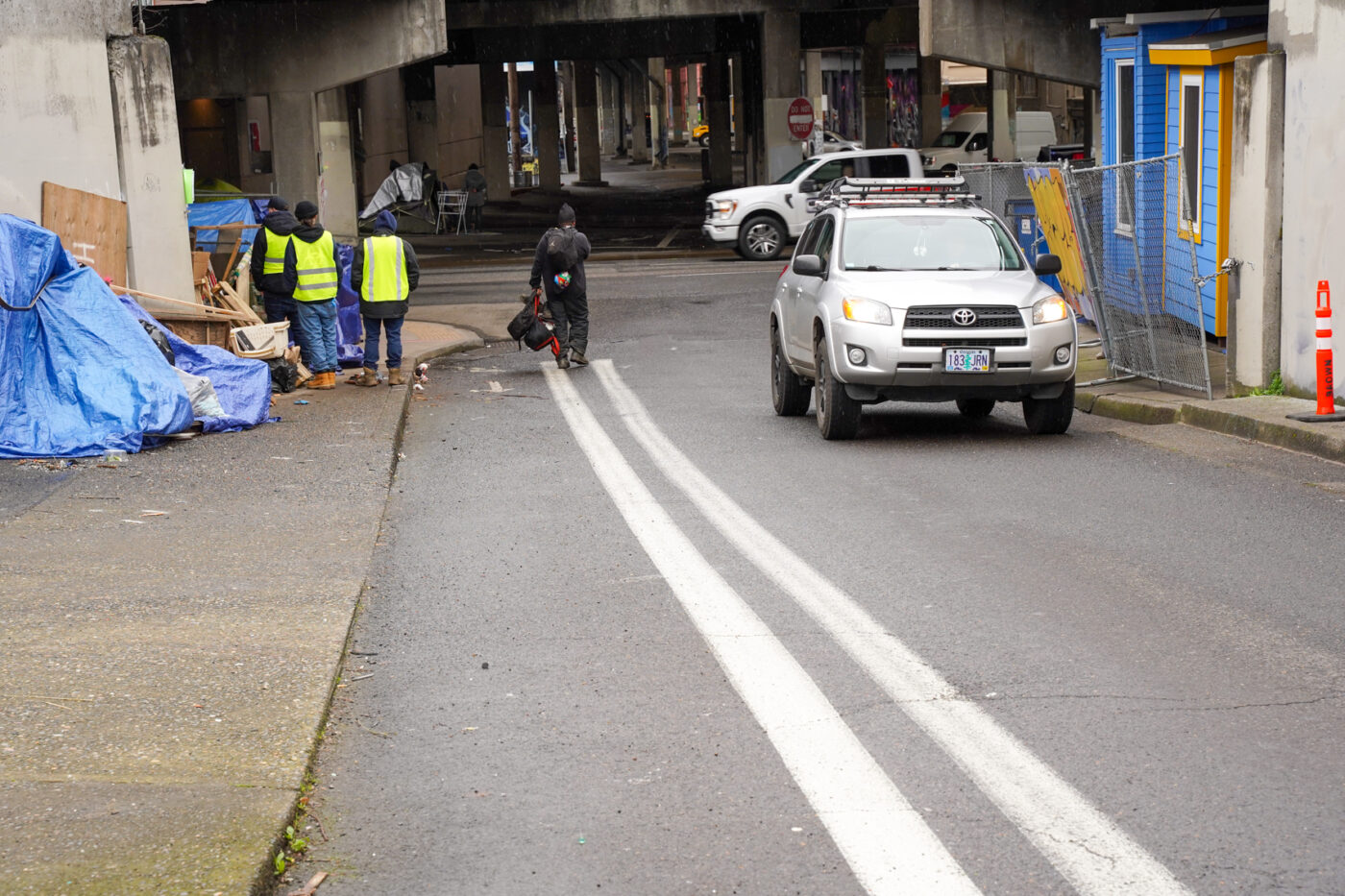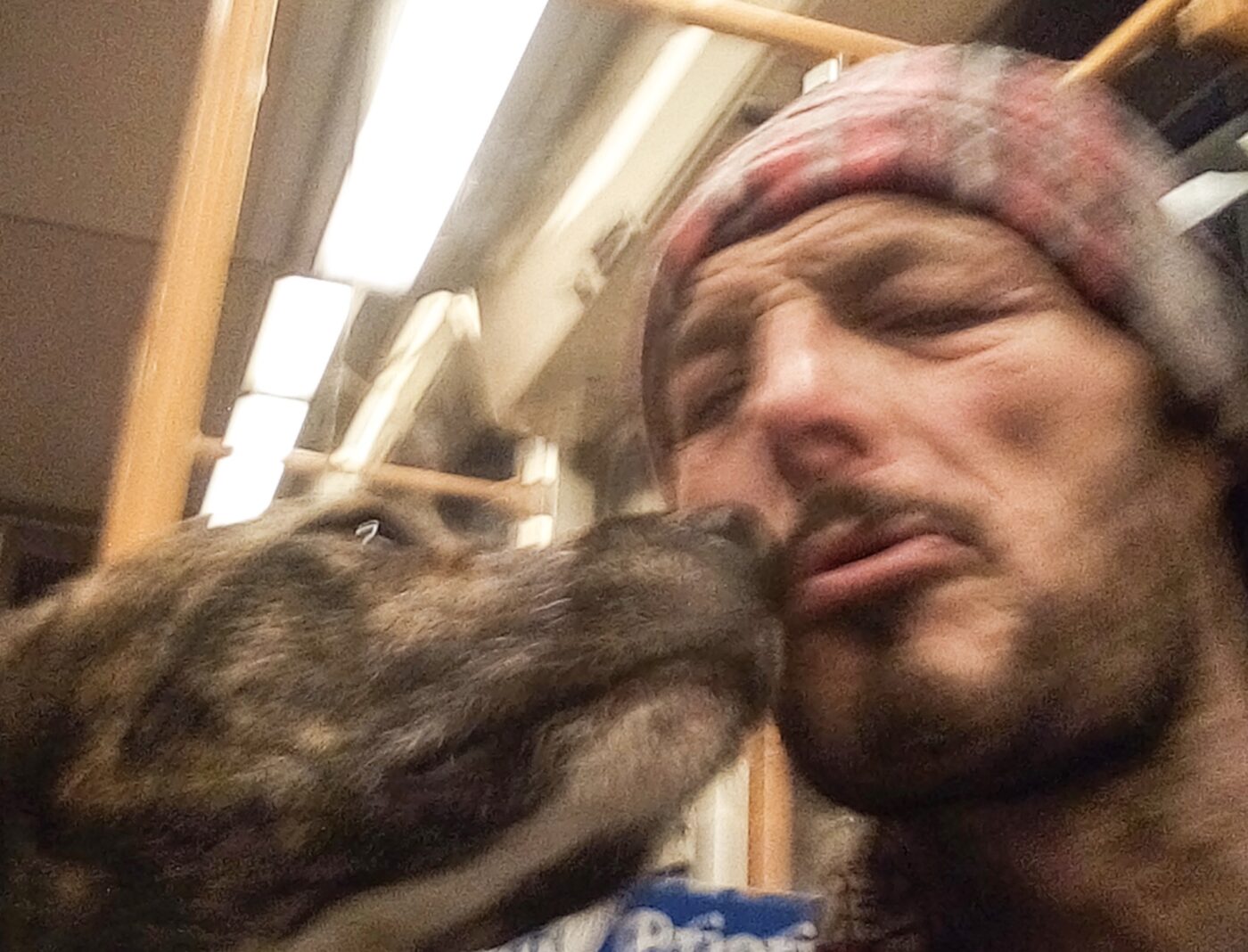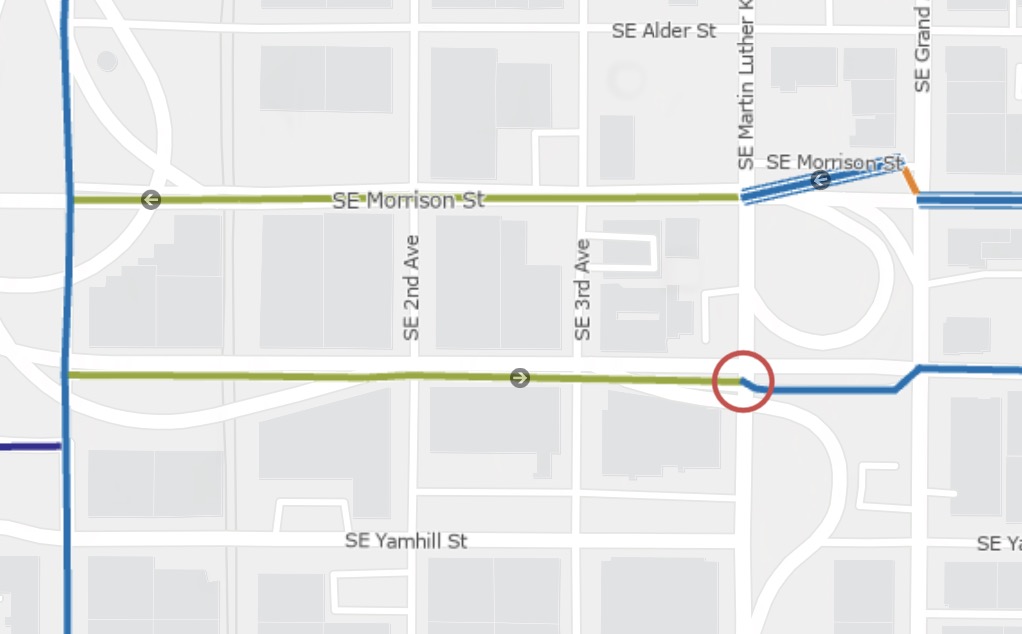
Violent and allegedly intentional actions led to the death of 49-year-old David “Dino” Bentley on Southeast Belmont in the Buckman neighborhood early Sunday morning. What initially seemed like the result of a dangerous street design mixed with the inherent risks of people who live in homes made out of fabric and thin wood pallets on the sidewalk, now seems to have been something much different.
I spent time at the scene Wednesday afternoon, I’ve reviewed the court documents, and have watched and read local news coverage to try and understand what happened, and why.
Here’s what I know so far…
The man who drove his car into Bentley, 22-year-old Shane McKeever, is currently being held on charges of Manslaughter in the First Degree and Reckless Driving. The probable cause affidavit filed at the Multnomah County Courthouse on Monday relays a harrowing tale that began with what one witness described as an argument. “The suspect [McKeever] walked into the camp and started to argue with everyone,” one man told a Portland Police officer who responded to the scene. “It seemed like the suspect was looking to cause issues.” There was also an allegation from someone in the adjacent encampment that McKeever “threatened to run over their camp.” Then McKeever allegedly got into his car and made good on those threats.
According to the court docs, which were based on witnesses both on the ground and one person who saw it from a window of his apartment at the Grand + Belmont building, McKeever first hit Bentley by driving (an allegedly stolen car) from SE Belmont (under the Morrison Bridge viaduct) across Martin Luther King Jr. Blvd, then continued eastbound on Belmont. A different witness estimated McKeever’s speed at 40-50 mph. Bentley was sitting stationary on his bike, either in the bike lane or on the southern sidewalk of Belmont between MLK and Grand with his back toward the approaching driver. A video from KGW shows the impact left a large dent in the hood of the medium-sized Chevy Malibu sedan and smashed-in almost the entire windshield. The witness in the apartment building heard the loud impact and told police McKeever then turned around in a nearby driveway and drove back (westbound) on SE Belmont and “appeared to be intentionally trying to run people over in the camp.” It was at this point that witnesses heard 4-5 gunshots.
McKeever stopped the car about 10-feet east of MLK and tried flee on foot. He was eventually approached by witnesses and ultimately apprehended by police on SE Belmont a few blocks west of MLK.
David Bentley (victim)
David Bentley, who went by “Dino” on the street, seemed to have a lot of friends. He had been living on the streets of Portland for years and KGW interviewed him during the heat wave last summer, when he told one of their reporters: “I don’t want to die out here. I don’t want to die just another homeless guy, just another number.” Mayor Ted Wheeler said in a statement that Bentley was well-known to local outreach workers, that the Mayor’s office was “sad to learn” of Bentley’s death and that the incident was a, “sobering testament of how dangerous living on the streets can be.”
I’ve spent some time trying to track down people who knew Bentley in hopes they can paint a fuller picture of him. So far I’ve only managed to find someone who calls Bentley a brother. The person posted a direct message on their Facebook page late Sunday night that she’d sent to McKeever. “My heart is so broken,” the message read. “Why did you hit my brother with your car?… Why did you run? How come you didn’t get out and try to help my brother? But rather try to run over my son too?”
Shane McKeever (suspect)
McKeever has had many run-ins with the law in his short life. According to his record, he’d been charged with five felonies and two misdemeanors (for theft) since 2021 — not including his current charges. Those charges include multiple counts of criminal mischief, assault, menacing, unlawful use of a weapon, and contempt of court for failing to appear. He’s been convicted of two separate domestic violence assaults.
Photos and messages shared by McKeever on what appears to be his Facebook page, paint the picture of a young man who embraced “the hustle,” liked to smoke, and celebrated handfuls of cash. He also shared that he didn’t receive a lot of guidance in life from people close to him and that he was homeless and lived in his car for at least seven months in 2021. That same year, McKeever wrote that he, “never had a father figure growing up to teach me how to take care of something like this,” and that he, “never had a family base.” He was also married and he and his wife had a daughter in 2020.
McKeever is scheduled to be arraigned on March 5th.













The Infrastructure
I’ve heard a lot of concern from the community about the design of this block of SE Belmont between MLK and Grand. I observed it from all angles yesterday and the concerns are valid. It’s also notable that the intersection of Belmont and MLK is circled in red and labeled as a “difficult intersection” in the official City of Portland bike map (see graphic at right).
One reason it’s a high-stress area for bicycling and walking is that it’s a relatively narrow (about 15-feet wide) street striped with a bike lane that handles traffic between two very wide (about 50-feet), car-centric and busy urban arterials. Belmont is clearly a recommended bike route because it has sharrow markings from SE Water (near the river) and the buffered bike lane where Bentley was hit. The buffered bike lane was striped in late 2017 or 2018 and it helps Belmont connect to bike lanes further east. In the bike network, this section of Belmont is a couplet with westbound Morrison St. one block north.
The presence of viaducts overhead and the columns that support them adjacent to this little stretch of Belmont reduces visibility. The stressful, multi-lane arterials on either side also contribute to driving behaviors that don’t always keep safety of non-drivers in mind. That being said, the left-turns from MLK onto Belmont have such bad visibility and require such a tight radius, that I didn’t see a lot of speeding or dangerous driving around that movement. The curb at the Belmont/MLK corner bulbs-out a bit, which helps protect the bike lane by creating a shadow of protection. Being out there I realized it’s much easier for drivers to reach dangerous speeds when they come from Belmont west of MLK.
As you can see in the video below, drivers (or bike riders) who cross MLK Jr. Blvd from Belmont face four lanes of relatively speedy, one-way traffic.
Homelessness
This is as much a story about our continued struggle to house all Portlanders, as it is about a traffic crash.
While I was out there yesterday, a crew from Rapid Response Bio Clean, a company paid by the City of Portland to address homeless camps, drove up in one of their big box trucks. Workers got out and talked to the folks who live in the tarp-and-pallet shelters being used as homes by many people adjacent to where Bentley was killed. They were probably informing them that the camp will be “swept” this coming Monday, March 4th. An “Illegal Campsite” notice — posted to the same pole as a memorial roadsign erected by road safety activists earlier this week — went up on February 23rd.
Where will these folks go next? Will it be just as close to dangerous traffic? Will they move into shelters? Are there even enough places for them to find a bed? As long as people continue to live so close to deadly vehicular weapons, should we consider emergency road design changes to respond to the reality of these ticking time-bombs of traffic tragedy?
Conclusion
Given what we know so far, it feels like there isn’t one clear thing that bears responsibility for the events that unfolded early Sunday morning. It was a violent act carried out by a repeat offender who never got the help he needed, in a city where far too many people live precariously close to large deadly weapons on four wheels that can careen into them at any time — whether their drivers intend to or not — and far too often with heartbreaking consequences.






